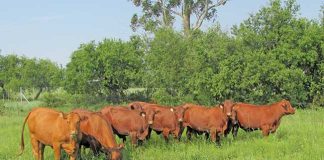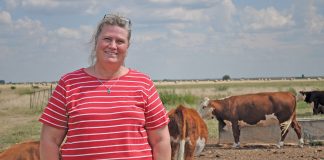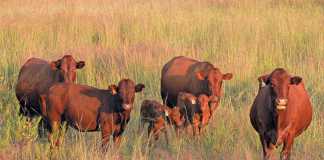When it comes to cattle breeding and veld management, veteran cattleman Johann Zietsman has no truck with those who pass off “academic bull” as convention or science. The bottom line, says Johann, is that by using conventional methods unchanged since the 1950s, “many cattleman are producing at less than 50% of their potential because their cattle are not managed optimally, production costs are increasing, veld is degrading and carrying capacity declining”.
The good news, he adds, is that it need not be this way. In Man, Cattle and Veld (BEEFpower LLC), Johann shows how ultra- high density grazing (UHDG) and other practices can revolutionise cattle farming. The book is the culmination of almost 30 years of extensive on-farm research and personal experience as a hands-on cattleman. “I wouldn’t be comfortable sharing this knowledge if I hadn’t done it myself,” says Johann, who studied at the University of Pretoria under Prof Jan Bonsma to graduate with a BSc Agric in Animal Science in the early 1970s.
He currently runs a consultancy from Chinhoyi, Zimbabwe, and travels around the world helping other cattlemen to optimise their veld management and cattle production to achieve maximum sustainable profit per hectare.
Mindshift
Johann’s Eureka moment came on 12 January 1995, “a day I’ll remember clearly for the rest of my life”, he recalls. It was the day he started practising ultra-high density, quick-rotation grazing on Pumula, his 800ha sourveld farm in Zimbabwe’s Karoi district. Johann used a single-strand portable electric fence – the most cost- effective system – to divide the farm into 2 000 camps. He initially put 90 cattle on strips of around 0,3ha each, let them graze the grass right down, and then moved them every two to three hours.
Within two weeks of introducing UHDG, he had to double the stocking rate – and this in the driest year on record. Two years later, he trebled the original stocking rate. By the time Johann was forced off his farm by the Zimbabwe land invasions, the soil fertility and the diversity of good grass species had increased to such an extent he could quadruple the number of cattle he originally ran on the same land to a stocking rate of 1ha/MLU. Veld that had just been grazed would be rested for a few weeks to several months.
In 1995, Johann had 86% unpalatable, 9,5% semi-palatable and 4,5% palatable grass species. One year later, he had 46% unpalatable, 28% semi-palatable and 26% palatable species. However, he is quick to emphasise that this was an ‘extreme’ set-up and cattle farmers must establish what works best in their specific environmental conditions within the high density to ultra-high density continuum.
“The combination of grazing, hoof action, dunging and urinating resulted in the quality of the grass and species diversity improving dramatically,” recalls Johann. Soil fertility increased, as did earthworm and dung beetle numbers, while the condition and production of the cattle improved dramatically, “relative to non-selective grazing at low stock density”.
“We had crossed several barriers – especially those of herd size and stock density,” he explains. “It was ranching on a different plane. I then clearly understood what John Acocks, the vegetation doyen and non-selective grazing pioneer, meant when he said in the early 1950s: ‘South Africa is overgrazed and understocked’.” Johann calls this “one of the most profound statements ever in the field of natural resource management”.
A low stocking rate can produce good-looking animals, but it is not good for the veld. “Profit from cattle is about improving the veld through well-managed, high intensity, quick-rotation grazing,” he stresses. “It is based on good and sustainable profit per hectare, not on individual animal performance.”

Steenbokpan, Limpopo, in the rainy season (January). The foreground shows
the effect of UHDG; the ungrazed section is in the background.
Detractors
Despite its visible benefits on the veld, the excellent condition of his cattle and his profits, Johann’s high stocking rate and UHDG method has its detractors, as he describes in his book. A group of South African academics and scientists were openly hostile to his approach, without taking the opportunity to visit him and see the results for themselves. They were not alone, adds Johann. Most academic institutions, organisations and breed societies are more interested in defending the status quo than in innovation.
“Institutions and research centres should be transformed into innovative model ranches for the 21st century, focusing on developing and testing sustainable methods of livestock production and veld restoration,” he says. Conventional cattle management, “where cattle are put in a camp for a period of time, cannot be described as management,” he says.
“It’s more like a hunter-gatherer situation. Management, in terms of grazing, means controlling each hoof and mouth relative to animal impact, selectivity of grazing, and time on and off an area of land. This type of control requires making decisions on an hourly to daily basis, the essence of management.”
He argues that conventional management and breed society standards, presented as ‘best practice’, are in reality merely contrived perceptions about what a group of people regard as the ‘ideal’ bull, ‘ideal’ cow, ‘ideal’ calving weight, ‘ideal’ weaning weight, ‘ideal’ carcass weight and so on. “Among cattle breeders in the 1950s the ‘ideal type’ of beef animal was an overfed dwarf,” he claims.
“In an overreaction to this, the ‘ideal type’ of the 1980s was a lanky slab-sided freak (draadkar), the progeny of which had difficulty fattening in the feedlot, let alone on the veld. “Now [breeders] seem to prefer a ‘middle-of-the-road type’, whatever that means.”
All about fashion
Cattle show judging and herd inspections have nothing to do with cattle, says Johann. Instead, “they have everything to do with fashion and man’s ego and the consequences are negative and far-reaching”. Although visual appraisal does have a place in selection, practical fertility – inherent body condition in addition to hormonal balance – is more important. “What logic is there in culling a good, fertile bull or cow simply because they do not conform to the ‘ideal type’?” asks Johann. “Or discriminating against a certain colour, colour marking – or lack thereof – or twist of the scrotum when investigation has proved no relationship with fertility?
“Or, worse still, culling the most veld-productive cattle on the basis of man-made growth criteria – weaning weight, weight for age, average daily gain?
“I would argue that some of the best bulls have been slaughtered and some of the best genetic material has been lost because of breeders regarding them as ‘not big enough’. This ‘bigger is better’ trend is purely based on perception and fashion rather than on productivity.”
He points to the big difference between veld cattle and stud cattle, which are too often reared to look good in artificial conditions. Veld cattle have to produce in a natural environment under the natural law, notably ‘survival of the fittest’. Johann has the greatest regard for innovative cattle and veld pioneers across a range of disciplines who recognised this. Apart from John Acocks and Prof Jan Bonsma, they include Beefmaster pioneer Tom Lasater and holistic management practitioners Stan Parsons and Alan Savory.
This does not mean he accepts their theories without question; in fact, he thinks that some of their policies and practices are contrary to good cattle and veld management. Two examples of the ‘good’ and the ‘bad’, one involving Bonsma and the other Savory, illustrate this.
The good and bad of Bonsma
Johann praises Bonsma’s role in popularising the concept of hormonal balance and its influence on practical fertility. “There is a big difference between academic fertility and practical fertility,” he explains.
“A very masculine bull with a perfect hormonal balance possesses an extremely important determinant of fertility. But this is only of value if he can also sire female progeny which, in addition to being very feminine (hormonally balanced), are genetically predisposed to good body condition. Practical fertility requires early sexually maturing heifers that are also physiologically early maturing and can maintain body condition.”
This enables calving at two years on the veld and a high re-conception rate with minimal human assistance and “has a positive influence on the bottom line”. Johann goes on to discuss some of the flaws he sees in Bonsma’s approach to breeding. “My first inkling [of these flaws] came when I witnessed an extremely well-muscled young Bonsmara bull being culled at the Irene Bull Testing Station solely on account of a small white spot on its forehead,” he recalls.
“I am convinced that this legacy of unwarranted sensitivity to colour, shape and type has had, and is still having, a detrimental effect on the productivity of the Bonsmara.” Moreover, this obsession with colour excluded the Nguni in the composition of the Bonsmara. Had the Nguni been included, “the Bonsmara would have been even more productive, particularly in respect of veld adaptation and fertility”.
The good and bad of Savory
Johann praises Allan Savory’s innovative high-intensity, quick-rotation approach to grazing, which mimics the ecological effect of migratory herds. However, he criticises Savory for neglecting body condition and production under different environmental conditions and seasonal variations to ensure that cattlemen breed nutritionally adapted cattle.
“Savory alienated many farmers and independent thinkers with his obtuse holistic vision and goals, instead of focusing on the very real issues,” says Johann. “Where I come from, in the north of Zimbabwe, we would get 1 000mm of rain in four months. The grass grew incredibly quickly and there was a lot of it." But 86% of this was the very fibrous Sporobolus pyramidalis, while the more palatable grasses, such as the Setaria species, were in the minority.
Cattle under pressure
“I had to find a non-selective grazing method to graze down the grass sward, soften it and break the capping of the soil. But at the same time I had to make sure that I maintained good condition and production in the cattle,” explains Johann. When cattle used to grazing selectively are put into a system in which they are under pressure to graze non-selectively (to improve the veld), their condition drops.
“To compensate for this, I realised I needed a hardy, 250kg to 450kg cow with a high grass intake relative to her size,” says Johann. “Smaller-framed cattle with African genetics, such as the Nguni and Angoni, are ideal for this. “I realised my Beefmaster herd needed indigenous genetics to achieve this smaller body size, hardiness and natural resistance to parasites and disease. I favour adapted genotypes above dipping and dosing, which are expensive and detrimental to the environment.
“All we’ve been doing over the past 100 years is to breed dip-resistant ticks instead of tick-resistant cattle.”
Johann put a Mashona bull on his cows. Similar to the Nguni, it is “without doubt the hardiest and most parasite- and disease-resistant breed in South Africa,” he claims. “I subsequently introduced Angoni and Boran. There are so many fascinating breeds of African cattle. The hybrid vigour obtained from crossbreeding African breeds with British or European breeds typically produces strong, resistant cattle that gain weight well.”
Johann urges cattlemen to time calving as close as possible to the month after the seasonal rain starts. In this way, the cows will be in a better body condition, reconceive faster and achieve a desirable inter-calving period. “I am not a slave to high weaning weights,” he stresses. “A 40% to 45% weaning weight is fine. A cow with too much milk may sacrifice body condition and can take longer to conceive again.”
African grasses
While Johann is highly conscious of the condition of cattle, he remains equally conscious of the condition of the veld.
“African grasses have evolved under severe grazing from migratory herds of game,” he explains. “But they take time to recover. If grazed before it has had time to recover, the plant becomes weaker. This is what happens with continuous grazing, or poorly managed rotational grazing.
“The length of time grasses need to rest depends on the environment. A drier environment requires a longer recovery period.”
Johann suggests that cattlemen create grazing strip tests to experience the effect firsthand. “I know that many South African farmers have labour problems, but once the system is established, it is so simple that the farmer or one good worker can manage it,” he says.
“A supplementary lick containing urea to feed the rumen bacteria is crucial for cattle on veld with a high percentage of moribund or lignified grasses or shrubs. “Successful cattle farming is all about keeping your eyes open, observing your cattle, your veld and your wallet to see what works for you.”
Email Johann Zietsmann at [email protected], or phone him on (Zimbabwe) 00 263 778 073 349.













